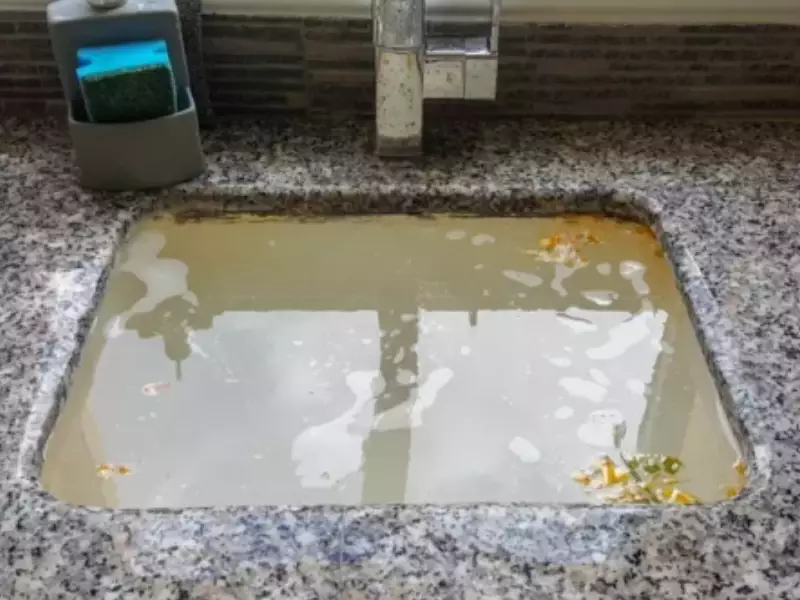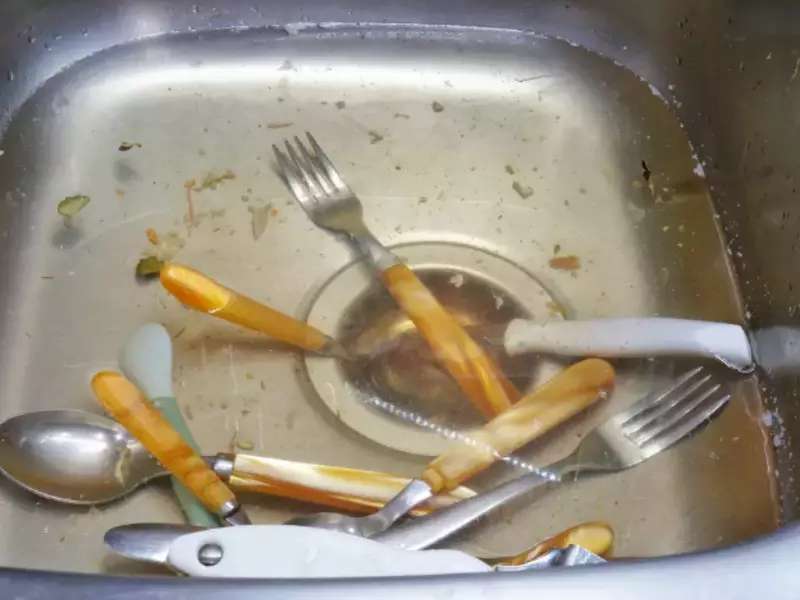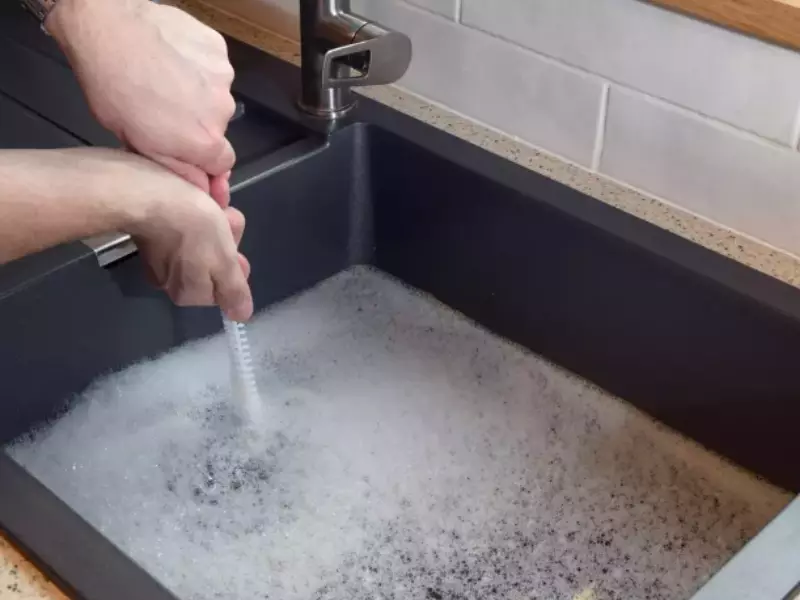When your kitchen sink becomes a stubbornly clogged nightmare, it can disrupt your daily life and lead to unwelcome plumbing issues. We’ve all had the experience of water pooling around dishes, bad smells, and a helpless feeling.
So what’s the fix for this everyday home problem? How to clean kitchen sink blockage? In general, it all comes to the point of identifying the reasons, using the right tools, and taking corrective measures.
In your quest for a smoothly flowing kitchen sink, knowledge is your best ally. Get ready to equip yourself with the essential know-how, from grasping the culprits behind sink blockages to mastering the art of clearing them. No more vague solutions or DIY frustration. Let’s dive into the world of kitchen sink maintenance and ensure you have the tools – both literal and figurative – to maintain a pristine sink.
Let’s get straight to the point with a short and simple response: we’ll walk you through every step of the process to overcome kitchen sink blockages and make sure they disappear forever.
Identifying Sink Blockages
The first step in preventing and fixing kitchen sink blockages is knowing what causes them, even if they can be quite annoying. We’ll examine the causes of sink clogs in this section and highlight the value of regular upkeep. So, let’s get started:

Causes of Kitchen Sink Blockages
Kitchen sink blockages typically result from a combination of factors, including:
- Food Scraps: Leftover food particles that get washed down the drain can accumulate over time, forming blockages.
- Grease: Pouring hot, greasy liquids down the sink may seem harmless, but as they cool, they solidify and contribute to clogs.
- Foreign Objects: Tiny kitchen equipment or utensils that are accidentally dropped down the drain might clog the pipes.
Importance of Regular Maintenance
Regular maintenance of your kitchen sink can save you from the frustration of dealing with blockages. Here’s why it matters:
- Preventive Measure: Regular maintenance can stop obstructions before they start. Food particles can be stopped from getting into the pipes using easy procedures like utilizing drain catchers.
- Early Detection: By regularly checking your sink, you can identify possible problems before they become serious clogs. Time and money can be saved with early detection.
- Prolonged Lifespan: You can minimize the need for expensive replacements by maintaining your drainage system and sink.
Statistics and Facts
To highlight the prevalence of sink blockages, consider the following statistics and facts:
- Approximately 85% of plumbing calls are related to sink and drain blockages. This common issue costs homeowners significant time and money.
- The average household disposes of over 150-180 pounds of kitchen waste per year. Much of this waste ends up in sink drains, contributing to blockages.
- Untreated kitchen sink blockages can lead to more extensive plumbing problems, often requiring professional intervention.
Now that we understand the causes and importance of regular maintenance, let’s move on to the tools and materials you’ll need to tackle kitchen sink blockages effectively.
Tools and Materials
To unclog a kitchen sink, you need to make sure you have the right materials and tools on hand. Here’s a detailed inventory of everything you’ll need, along with recommendations for where to buy it.
Essential Tools for Clearing a Sink Blockage
- Plunger: A sink plunger is a fundamental tool for dislodging minor blockages. Ensure it has a snug seal to be effective.
- Pipe Snake: A pipe snake, also known as a drain auger, is essential for tackling deeper or more stubborn clogs. It allows you to reach blockages that a plunger might not.
- Bucket: Keep a bucket on hand to collect water and debris that might come up during the cleaning process. This prevents mess and makes disposal easier.
- Gloves: Rubber gloves are vital for protecting your hands from exposure to contaminants and cleaning products.
- Cleaning Products: Depending on the severity of the blockage, you might need cleaning products like drain cleaner. Make sure to read the product label carefully and follow safety instructions.
Where to Find These Tools and Materials
You can purchase the necessary tools and materials from various sources, including:
- Local Hardware Stores: Visit your nearest hardware store to find a wide range of plumbing tools and safety gear.
- Online Retailers: Online platforms like Amazon and eBay offer a convenient way to purchase plumbing tools and supplies from the comfort of your home.
- Home Improvement Centers: Stores like Home Depot or Lowe’s are reliable options for high-quality plumbing tools and materials.

Step-by-Step Cleaning Process
It’s not always a difficult process to clear a blockage in the kitchen sink. You can quickly repair the functionality of your sink if you have the correct methods and equipment.
Let’s share the cleaning procedure into five simple stages:
1. Clearing Debris from the Sink
- Begin by removing visible debris from the sink, such as dishes and leftover food scraps. Use a spatula or your hands to collect the larger particles.
- To ensure efficient disposal, use a trash bag or a bin dedicated to organic waste. This is far better than rinsing food scraps down the drain, as they can contribute to future clogs.
2. Preparing the Sink
- To prepare the sink for cleaning, you need to plug it securely. This step helps avoid splashing and creates a seal, which is essential for effective plunging.
- You have a few options for plugging the sink: you can use a cloth, a sink stopper, or even a plastic container to seal the drain. Ensure it fits snugly to prevent water from escaping.
3. Plunging
- Plunging is an effective way to dislodge minor blockages. Follow these steps for a successful plunge:
- Position the plunger over the drain, ensuring it covers the entire opening.
- Press down and then pull up with steady, controlled force. This motion creates suction, which can help dislodge the blockage.
- Maintain a steady rhythm while plunging, and be patient. It may take several attempts to clear the blockage fully.
- Creating a tight seal between the plunger and the sink’s surface is crucial for optimal results.
4. Using a Pipe Snake
- For more stubborn or deep-seated blockages, a pipe snake, also known as a drain auger, comes to the rescue. Here’s how to use it:
- Insert the snake into the drain as far as it can go.
- Turn the handle clockwise to navigate through the pipe and locate the blockage.
- When you encounter resistance, it’s likely the snake has reached the clog. Continue turning the handle to break up the blockage and clear the drain.
5. Flushing with Hot Water
- After successfully clearing the blockage, it’s essential to flush the drain with hot water. This step helps remove any remaining debris and prevent future clogs.
- Boil a kettle of water, and carefully pour it down the drain. The hot water will help dissolve and flush away any remaining grease or particles.
Now that you’ve successfully cleared the blockage, let’s explore the use of natural and DIY cleaners to maintain a clog-free sink.
Natural and DIY Cleaners
Harsh chemicals are not always necessary to maintain a clear and unclogged sink. You can use organic and natural cleaning products that are safe for the environment and your pipes. Using common household ingredients, here are some suggestions for making DIY cleaners:
- Baking Soda and Vinegar: Vinegar and baking soda are an effective combination that works wonderfully for keeping your sink clear. Just pour around half a cup of baking soda and a cup of vinegar down the drain. After a few minutes of sitting, flush with hot water.
- Lemon Juice: Lemon juice’s natural cleaning power comes from its acidity. After you squeeze a lemon into your drain, allow it to sit for a little. To assist in preventing obstructions and to freshen the drain, use hot water immediately.
- Salt and Baking Soda: Mixing equal parts salt and baking soda can be an effective abrasive cleaner. Sprinkle this mixture down the drain, add some hot water, and let it work its magic.
These natural cleaners not only help prevent blockages but also leave your sink smelling fresh and clean. As we wrap up the cleaning process, let’s discuss preventative measures to keep your kitchen sink clear.

Preventative Measures
Preventing kitchen sink blockages is an ongoing effort that involves adopting good habits and taking a proactive approach to sink maintenance. Here are some preventative measures to keep your sink flowing smoothly:
- Use Drain Catchers: Install drain catchers or strainers in your sink to trap food scraps and prevent them from entering the drain.
- Avoid Pouring Grease: Instead of pouring hot grease down the sink, collect it in a container and dispose of it in the trash. Grease can solidify in the pipes, contributing to blockages.
- Regular Hot Water Flushing: Make it a routine to flush your sink with hot water periodically. This can help dissolve grease and prevent buildup.
- Stay Mindful: Be aware of what you’re putting down the sink. Avoid flushing items like coffee grounds, eggshells, and starchy foods, which can contribute to blockages.
Frequently Asked Questions
Q: What causes kitchen sink blockages?
A: Kitchen sink blockages typically stem from a buildup of food scraps, grease, and foreign objects in the drainpipes. Over time, these materials create clogs that restrict the water flow.
Q: What tools are essential for clearing a sink blockage?
A: To tackle a sink blockage, gather key tools, including a plunger, a pipe snake, a bucket, gloves, and, if desired, natural cleaning products like baking soda and vinegar.
Q: How should I safely handle cleaning products for sink blockages?
A: Safety is paramount. Always wear gloves and protective eyewear when dealing with cleaning products to shield yourself from any harmful substances. Carefully read product labels and follow safety instructions.
Q: Are there natural and DIY cleaners to prevent sink blockages?
A: Absolutely! You can create effective, eco-friendly cleaning solutions using everyday ingredients like baking soda, vinegar, and lemon juice. These natural cleaners work wonders in preventing blockages and keeping your sink clean.
Conclusion
Your kitchen sink should be a reliable ally in your daily cooking adventures, not a source of frustration. A clogged sink can disrupt your routine, lead to unpleasant odors, and even lead to costly installation problems. However, with the knowledge and tools provided in this article, you will be well-prepared to effectively deal with how to clean kitchen sink blockage.
By following the steps listed here, from removing debris and using the right tools to using natural cleaning solutions and taking precautions, you can take control of your sink’s fate. Don’t wait for the sink to give you a headache.
Take action today and enjoy the satisfaction of a smooth-flowing kitchen sink, meal after meal. Say goodbye to seals and say hello to hassle-free sink maintenance. Your kitchen and your peace of mind will thank you!
Leave a Reply